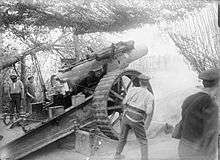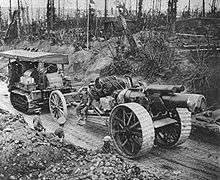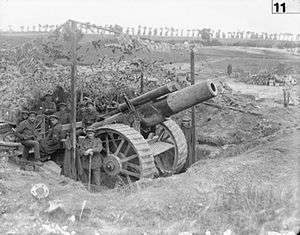BL 8-inch howitzer Mk I–V
| BL 8-inch howitzer Mk V | |
|---|---|
|
Eight-inch howitzer Mk V near Carnoy, Battle of Albert, July 1916 | |
| Type | heavy howitzer |
| Place of origin | United Kingdom of Great Britain and Ireland |
| Service history | |
| In service | 1915−1918 |
| Wars | World War I |
| Production history | |
| Designer | Major M L Wilkinson, RGA[1] |
| Number built | 91[2] |
| Specifications | |
| Weight |
Gun & Breech: 5 Long tons[3] Total: 13.5 Long tons[4] |
| Barrel length |
Bore: 9 ft 10 in to 10 ft 5 in (3.00−3.18 m) |
|
| |
| Shell | HE : 200 lb (91 kg), bagged charge |
| Calibre | 8 inches (203 mm) |
| Recoil | Hydro-spring constant. 18-, 13- or 13.25-inch[5] |
| Elevation | -5°−45° |
| Traverse | nill |
| Muzzle velocity | Maximum: 1,301 ft/s (397 m/s) |
| Maximum firing range | 10,500 yd (9,600 m)[6] |
The BL 8-inch howitzer Mark I through to Mark V (1 to 5)[note 1] were a British improvisation developed early in the First World War to provide heavy artillery. It used shortened and bored-out barrels from various redundant naval 6-inch guns.
It bore no relation to the later 8-inch howitzer of the First World War, the Vickers 8-inch Mark VI to VIII howitzers which succeeded it.
History
The weapon entered service in February 1915.
The Mark I–V had many relatively minor differences in the carriages and trails and Mk IV, Mk VI and QF Mk II 6-inch naval gun barrels were used.[note 2] However, the ballistic characteristics, propellant charges and shells used were similar for all Mks I–V. They are easily identified by their short thick barrel and twin recoil buffers above the barrel.
Mks I–IV were no longer repaired from summer 1917 onwards.[7]
Combat use

They were operated by siege batteries of the Royal Garrison Artillery (RGA). Holt caterpillar tractors were used to tow them into position.
Mks I–V were limited by a short range and high weight, being 4–5 tons heavier than the succeeding Mk VI which was designed as a howitzer and hence had a much lighter barrel.
The improvised nature of the design led to failures such as premature explosion and unreliability in action, and difficulties of maintenance in workshops. There were also early quality-control problems with British mass production of ammunition in 1915 and early 1916 : "the 8-inch fuses failed so often that the battlefield was littered with unexploded 8-inch shells".[8]
Despite their shortcomings they were generally considered a success :
"They were monstrous things and extremely heavy, but the machinery of the guns was very simple and that's why they did so extremely well and didn't give nearly as much trouble as some of the more complicated guns that came to appear later on. One was the very first to be made and it was marked, 'Eight-inch Howitzer No. 1 Mark I' so we called that gun, 'The Original'. It was marvellously accurate". Second Lieutenant Montague Cleeve, 36th Siege Artillery Battery, Royal Garrison Artillery.[9]
They remained in use on the Western Front throughout the First World War as Britain's need for heavy artillery increased and was never fully met by production of modern equipment.
Photo gallery
-

Changing a barrel, which occurred frequently. Battle of Polygon Wood, September 26, 1917 -

Being towed by a Holt artillery tractor, Somme 1916 -
_(14595378490).jpg)
Three 8-inch howitzers in action
See also
- BL 8-inch howitzer Mk VI – VIII British successor
- List of howitzers
Weapons of comparable role, performance and era
- 21 cm Mörser 10 Approximate German equivalent
Notes
- ↑ I.e. models 1 through 5. Britain used Roman numerals to designate "Marks" or versions of guns until after World War II. Hence this article describes the first five models of British BL howitzer.
- ↑ Mk I used barrels from BLC guns Mk I/IV; Mk II & III used barrels from BL Mk IV or VI; Mk IV used BLC Mk I/VI adapted for Mk IV carriage; Mk V used QF Mk II barrels converted to BL (total of 63). Details from Clarke 2005, page 34, and Tony DiGiulian's website Britain 6"/40 (15.2 cm) QF Marks I, II and III
References
- ↑ Clarke, page 34. Major Wilkinson suggested the use of bored-out and shortened 6-inch (152 mm) naval gun barrels.
- ↑ National Archives MUN5/373/9227 : Mk 1 - 12 (Mar - Jul 15); Mk 2 - 6 (May); Mk 3–6 May Jun; Mk 4 - 8 Oct; Mk 5 - 4 Dec, + 59 1916.
- ↑ Hogg & Thurston 1972, Page 152. 5 tons is a rounded average for weight of gun with breech. Details: How Mk I 5 ton 6 cwt; Mk II 4 ton 19 3/4 cwt; Mk III 5 ton 2 1/4 cwt; Mk IV 5 ton 6 cwt;Mk V 5 ton 1 cwt
- ↑ Hogg & Thurston 1972, Page 152. 13.5 tons is a rounded average for total weight of gun and carriage. Carriage averaged 8 ton 8 cwt. Weights for the carriages with gun : Carriage Mk I with Mk I how : 13 ton 13 cwt; Carriage Mk II with how : 13 ton 11 cwt; Carriage Mk III with how 13 ton 3 cwt; Carriage Mk IV with how 13 ton 3 cwt; Carriage Mk V with how 13 ton 5 cwt
- ↑ Hogg & Thurston 1972, Page 153. Carriage Mk I 18-inch; Mk II, Mk 5 13-inch; Mk III, Mk IV 13.25-inch
- ↑ Clarke, page 35
- ↑ National Archives MUN5/373/9227
- ↑ Farndale 1986, page 135
- ↑ Transcription of an interview. IWM Sound: M.S. Cleeve, AC 7310, Reel 2. Quoted from "The Somme" by Peter Hart, published by Cassell, 2006. Page 82.
Bibliography
- Dale Clarke, British Artillery 1914–1919. Heavy Artillery. Osprey Publishing, Oxford UK, 2005 ISBN 1-84176-788-3
- General Sir Martin Farndale, History of the Royal Regiment of Artillery. Western Front 1914–18. London: Royal Artillery Institution, 1986 ISBN 1-870114-00-0
- I.V. Hogg & L.F. Thurston, "British Artillery Weapons & Ammunition 1914–1918". London: Ian Allan, 1972.
- Peter Hart, "The Somme". London: Cassell Military Paperbacks, 2006. ISBN 978-0-304-36735-1
External links
| Wikimedia Commons has media related to BL 8 inch Howitzer Mk I - V. |
- Video clips on YouTube:
- 8 inch Howitzer Marks I to V at Landships
